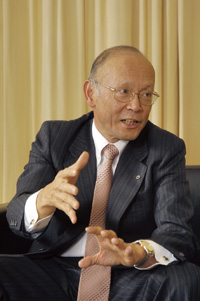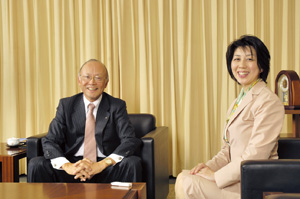 |
|
|
|
|
|
View from the Top Vol. 7, No. 1, pp. 1–4, Jan. 2009. https://doi.org/10.53829/ntr200901tp1  Becoming a Service Creation Business Group through Expanded CollaborationOverviewFor the first View from the Top article of 2009, we talked with Noritaka Uji, NTT Representative Director and Senior Executive Vice President in charge of the NTT Group°«s technical strategy, about NTT°«s strategy and activities toward a full-scale rollout of broadband and ubiquitous services. Decisive year for becoming a service creation business group—Mr. Uji, what are your aspirations for the New Year? In May 2008, the NTT Group announced a new medium-term management strategy called the °»Road to Service Creation Business Group°… [1], [2] toward enhanced services developed from the customer°«s point of view. I feel that 2009 will be the year that we expand new services that exploit the superb features of the Next Generation Network (NGN) and the third-generation mobile broadband network. (NTT°«s name for its NGN service is FLET°«S Hikari Next [3].) Of course, we must continue to expand the NGN service area, but from the customer°«s viewpoint, it is not so much a change in the network that°«s important but rather the provision of services that benefit all customers via the network. In this regard, 2009 will be a vitally important year for promoting both the expansion of the network and the creation of services that add value to the network. It will also be a year for building a foundation that will support the NTT Group for many years into the future. —The NGN is a popular topic, but what kind of network is it? As we approach a broadband and ubiquitous era, we can expect a further increase in network traffic and the appearance of diverse applications and services. With this in mind, and taking into account worldwide standardization trends, we began the gradual rollout of a new network called the NGN in March 2008, making use of optical fiber communications and Internet protocol (IP) technology for which much progress had already been made. The NGN features open interfaces, guaranteed quality of service (QoS), security, and reliability. It combines the reliability and security of the traditional telephone network with the convenience and cost efficiency of the Internet. Moreover, it simplifies the provision of triple-play services that provide video delivery together with telephone and Internet functions. The exchange of critical information within a corporation over the Internet presents some problems in terms of security and quality, but the NGN makes it possible to construct a highly reliable corporate network by guaranteeing security and communications quality over the network. NGN services: changing our lifestyles and the way we do business—What kind of services will the NGN be able to provide? Tailoring digital terrestrial broadcasts and movies to their personal lifestyles One service expected to be a pillar of consumer-oriented services is IPTV (service name: Hikari TV). Up to now, a user who wanted to watch a particular TV program would either tune in and watch it at the time of broadcast or record it for later viewing at a more convenient time. In contrast, the video on demand (VOD) feature in the NHK-on-Demand service launched in December 2008 enables users to select and view morning serial dramas or period dramas broadcast on NHK whenever they want. This means that users no longer have to worry about missing a program or forgetting to record it. Furthermore, through tie-ups formed with content providers and broadcasters, the IPTV service will enable users to enjoy digital terrestrial broadcasts and multichannel broadcasts in addition to VOD. To achieve these features, a variety of technical requirements will have to be met, including bandwidth guarantee to ensure the quality of video delivery, the control of video-delivery destinations, and the prevention of illegal copying. —It appears that the NGN will find widespread use in business too. SaaS: Revolutionizing the way we do business In the business world, software as a service (SaaS) is considered to be a pillar of corporate-oriented services. It enables the valuable information of a company to be processed over the network by external servers. In this sense, it has very high affinity with the NGN features of security and reliability. SaaS will change the way we do business. Up to now, the ordinary way of using accounting or other business software has been to purchase it beforehand. But SaaS will make it possible to use the software deemed necessary for business tasks by connecting to a system and accessing only that part of the software needed at the time. Constructing an information system and hiring a full-time system manager to oversee it can be costly for SOHO (small office, home office) users and small companies, but the use of SaaS can overcome this barrier.
High-presence video communication Misunderstandings can occur in exchange of text-based information such as email or fax messages are exchanged, but they can be resolved immediately in a meeting with the other party through face-to-face discussion. It is for this very reason that I place great importance on meeting directly with people on a regular basis. Nevertheless, it sometimes happens that time or physical constraints prevent me from making a visit. And I°«m sure that you have all experienced wanting to visit a friend or grandchildren living far away but being unable to do so for whatever reason. Such predicaments can be solved by the use of high-presence video communication services. Such services provide a significantly higher level of picture quality compared with earlier videophones, and they use many technologies to give users a sense that they are sharing the same space. For example, when a number of people are lined up across from each other in a videoconference and conversing, one such technology enables the speaker°«s voice to appear to come from his or her direction. Recently, a conference was held between the United States and Japan using telepresence technologies that made the participants feel as if they were really speaking with each other in the same place. I would like our customers to experience this sense of presence and also the convenience that such video communication can offer. Collaboration with diverse business fields such as financial or medical and service creation with various providers The coming of a network that can provide high security and reliability should give birth to services in new fields such as remote medical care and financial systems that require strict protection of personal information. These are just some examples of services that could be deployed on the NGN, but what I believe to be important here is collaboration with enterprises and providers looking to expand their businesses using the NGN. I have great expectations for services born of such collaborative efforts. Environmental load reduction by ICT—It has been said that the load on the environment can be eased by using ICT. Information and communications technology (ICT) enriches our lives while also protecting our livelihoods. In the same way that automobile manufacturers are making an effort to provide hybrids and eco cars to preserve the environment, the NTT Group is undertaking various environmental activities. These can be broadly divided into two types: reduction of environment load throughout society through the use of ICT and reduction of power consumption and CO2 emissions in the NTT Group itself. Two examples of environmental protection using ICT are video communication and teleworking. They enable a user to speak with someone far away with a sense of sharing the same space without having to travel to that person°«s location by train, car, plane, or other means of transport. The end result is a reduction in CO2 emissions by the amount that would be produced by such movement. Trial calculations have shown that the use of ICT can contribute to a significant reduction in environmental load even after we include the amount of power consumed by ICT itself. The NTT Group itself has put forward a °»Green NTT°… strategy and is working to reduce power consumption and CO2 emissions through the introduction of clean energy systems such as solar power generators and the deployment of DC power systems in data centers and elsewhere.
R&D supporting a future driven by ICTNTT Laboratories is leading the way in researching and developing technologies to promote the creation of services like the ones I°«ve been describing. These technologies are enriching our lives despite the fact that the general user may be completely unfamiliar with them. A major trend that can now be found among telecommunications carriers around the world is a shift toward optical communications. Optical technologies that have emerged from NTT Laboratories are on the world-class level. They will contribute to the overseas expansion of not only the NTT Group but also other Japanese companies. Many of these optical-fiber and optical-component technologies already have a large share of the world market. NTT Laboratories can take pride in the results achieved over several decades of optics-related research. —What kinds of services will come out of R&D pursued by a °»Service Creation Business Group°…? Research at NTT Laboratories is now being conducted in a variety of fields such as network technology, communications science, materials science, and environmental energy. This includes research with outlooks several decades into the future targeting advanced technologies like quantum computers and optical memory as well as research on next-generation network architectures. One example of a service that has great potential for expansion using technology developed at NTT Laboratories is digital signage. The basic idea is to present advertisements on displays in trains or on large wall-mounted displays in buildings. Up to now, each display has presented different advertisements in a stand-alone manner, but we have developed a system for networking this process and controlling advertisements for specific audiences, and we are now conducting trials to evaluate the business potential of this system. All in all, the system aims to make advertising more effective by delivering optimal advertisements in accordance with diverse characteristics such as the location and time of day and the gender, age, and number of people present, that is, in accordance with time, place, and occasion (TPO). NTT is also promoting the expansion of mobile/ fixed linkage services and Home ICT. Services that provide seamless linkage between fixed and mobile devices will enable users to use IPTV services and goo [4] search functions on their mobile phones in much the same way that they use them on their personal computers. Home ICT services, meanwhile, will connect not just personal computers but also home appliances such as game consoles, TV sets, digital photo players, and door intercom systems to the NGN. This will let a user remotely check whether the door to his or her home is locked, share photos and video by TV with family members living far away, make use of support services such as remote setting of devices and troubleshooting in the event of device faults, set up a virtual office to do work inside or outside the home, and do many other things. We are developing Home ICT services to enrich our lives while making them safer and more secure. NTT is collaborating with manufacturers and many service providers to provide Home ICT services that customers will evaluate as truly convenient. —Many services using advanced communication technologies are being developed. Some services that were called futuristic only a short time ago have already become a reality. This is really an exciting time isn°«t it? Yes, indeed. There is a gap between services that are technically possible and ones that are truly easy to use. NTT Laboratories is known for conducting much world-class research, but there are many points upon which it must reflect carefully. One of these is product usability. For this reason, it is important that we harness the overall power of the NTT Group to deal with problems that are difficult for NTT Laboratories to solve on its own and to promote business expansion from the customer°«s viewpoint. In addition to forming alliances with outside parties, we must promote collaboration within the NTT Group. This is being done by establishing task forces in which group companies hold discussions. At the same time, a worldwide viewpoint is becoming essential as we approach an era of service convergence and globalization. Although NTT is already active in NGN standardization activities and the expansion of its optical-component technologies overseas, it sees the need looking forward for collaborating with communication operators and partner companies in various countries and for disseminating its research and development results and expanding business. I believe that 2009 will be an important year for the NTT Group toward becoming a Service Creation Business Group. We plan to create more NGN services in collaboration with many enterprises. Our hope is that these efforts will stimulate growth in the Japanese economy.
ReferencesInterviewee profileCareer highlightsNoritaka Uji joined Nippon Telegraph and Telephone Public Corporation (now NTT) in 1973. He handled tasks related to NTT privatization and start-up business development. In 1988, he moved to NTT DATA, where he was initially in charge of planning and developing information systems for private enterprises. He then served in various managerial roles including director of the Next-Generation Information Services Sector, senior vice president and director of business planning, and senior vice president and director of enterprise-related sectors. Building on these experiences, he assumed the post of executive vice president in 2005. He began serving in his present position in 2007. |
|










